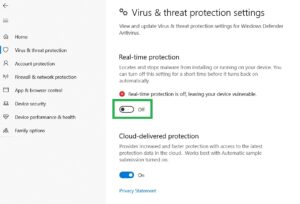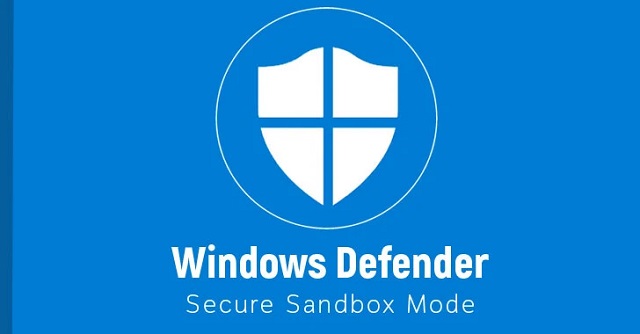How to Turn on Microsoft Defender Antivirus
Turn On Microsoft Defender Antivirus is a built-in program in Windows that can help protect your computer from viruses and malware. It can also be used to scan files and folders on your computer.
To turn on Microsoft Defender, open the Windows Security app. Click the Virus & threat protection settings, and then flip the Real-time protection switch on.
Enabling Microsoft Defender Antivirus is a straightforward process that involves navigating through the Windows Security settings. Follow the step-by-step guide below to turn on Microsoft Defender Antivirus on your Windows computer.

Step 1: Open Windows Security
- Press the Windows key on your keyboard or click on the Start menu button in the bottom-left corner of your screen.
- Type “Windows Security” into the search bar and press Enter.
2: Access Virus & Threat Protection
- In the Windows Security window, click on the “Virus & Threat Protection” option on the left sidebar. This will take you to the main security settings page.
3: Manage Settings
- Under the “Virus & Threat Protection” section, locate the “Manage Settings” link. Click on it to access the settings related to Microsoft Defender Antivirus.
4: Turn on Real-Time Protection
- Look for the “Real-Time Protection” toggle switch. Toggle it to the right to turn on real-time protection. Real-time protection continuously monitors your system for malicious activities and prevents potential threats in real-time.
5: Turn on Cloud-Delivered Protection
- Scroll down to find the “Cloud-Delivered Protection” option. Toggle the switch to the right to enable this feature. Cloud-delivered protection ensures that your antivirus definitions are always up-to-date by using Microsoft’s cloud service.
6: Turn on Automatic Sample Submission
- Below Cloud-Delivered Protection, find the “Automatic Sample Submission” option. Turn on the toggle switch to allow Microsoft to collect and analyze potential threats from your system, enhancing overall security.
7: Turn on Tamper Protection
- Continue scrolling to locate the “Tamper Protection” option. Enable this feature by toggling the switch to the right. Tamper Protection helps prevent unauthorized changes to your antivirus settings, enhancing the security of your system.
8: Check Exclusions (if necessary)
- If you have specific files or folders that you want to exclude from being scanned by Microsoft Defender Antivirus, you can do so by clicking on the “Add or remove exclusions” link. However, exercise caution when excluding items, as this may pose a security risk.
9: Verify Updates
- Microsoft Defender Antivirus relies on regular updates to stay effective. Ensure that your antivirus definitions are up-to-date by clicking on “Virus & Threat Protection” in the left sidebar and then selecting “Check for updates”.
10: Confirm Activation
- Once you have adjusted the settings as needed, go back to the main Windows Security page. Look for the “Your device is being protected by Microsoft Defender Antivirus” message to confirm that the antivirus is now active.
Congratulations! You have successfully turned on Microsoft Defender Antivirus on your Windows computer. Regularly check for updates and perform system scans to maintain a secure computing environment.
How To Turn On Microsoft Defender Antivirus?
The Windows Defender antivirus program protects your computer against malware, including spyware and viruses. It uses cutting-edge technologies, such as machine learning and behavior analysis, to identify and respond to threats. It also scans and removes malware that other security programs may have missed.
Microsoft Defender Antivirus is free and included in the Windows 10 operating system. It is updated regularly to protect against the latest threats. Its features include real-time protection, cloud-delivered protection, automatic sample submission, and controlled folder access.
To turn on Microsoft Defender Antivirus, open the Windows Security app and navigate to Virus & threat protection settings. Make sure the Real-time protection switch is set to On.
If you are unable to turn on the Microsoft Defender Antivirus software, there may be an issue with your Windows 10 installation or another piece of third-party security software. This MiniTool post explains how to fix these problems and restore Windows Defender to its full functionality.
How to turn on microsoft defender antivirus in windows 10
Microsoft Windows Defender antivirus software is a powerful tool for keeping your computer safe from malicious threats. It uses advanced technologies to identify and respond to emerging threats in real-time. It also integrates well with the Windows ecosystem. Originally known as Windows Security, the software has evolved over time to keep up with evolving threats. It now offers a variety of features, including real-time protection and cloud-delivered updates.
If you have been experiencing issues with Windows Defender, there are a few things that may be causing it to not open. One possibility is that a corrupted system file is preventing it from running correctly. Another possibility is that you have another antivirus software program installed, which may interfere with Windows Defender.
In either case, there are a few ways to fix the problem. You can try restarting your computer or using the registry editor to change a setting. You can also try a third-party antivirus software, such as KasperskyMcAfee.
How to turn on microsoft defender antivirus in windows 7
This article is about turning on Windows Defender antivirus (or Microsoft Security Essentials for the older Windows 7 and Vista OS) in order to help protect your computer from malware and spyware. This is a free, built-in software program from Microsoft that is often overlooked because users usually install other third-party antimalware programs on their computers like Avast, Bitdefender, McAfee, etc.
The first thing you should try is to restart the service that Windows uses to keep the tool active. You can do this by opening Run and looking for the Security Center service, then right-clicking it and selecting Restart.
If this doesn’t work, you can try to turn on Windows Defender by opening your settings and selecting Virus & threat protection. Open this and toggle the switches for real-time protection and cloud-delivered protection on. These are the only two options that guarantee that Defender will be turned on. If these don’t work, you may need to reset the app.
How to turn on microsoft defender antivirus in windows 8.1
If your computer isn’t currently protected against malware, the first step to take is to turn on Defender. This can be done by typing “action” into the search function, and clicking either the spyware or virus protection option from the results page.
Once Defender is activated, real-time protection will scan and monitor your system. When it detects anything that could be malicious, you’ll be notified and given the choice to allow it or move it to quarantine.
You can also enable Network Inspection System, which sends samples of any detected malware to Microsoft for analysis. You can also select whether or not to join Microsoft’s Malware Protection Center (MAPS), which will send basic information about any malware detected on your system, such as where it came from and how you dealt with it. This isn’t a requirement, but it’s an optional feature that many people choose to use. It’s important to note that Windows Defender may not be able to detect and prevent all forms of malware, so it’s best used in conjunction with other security measures.

Leave a Reply